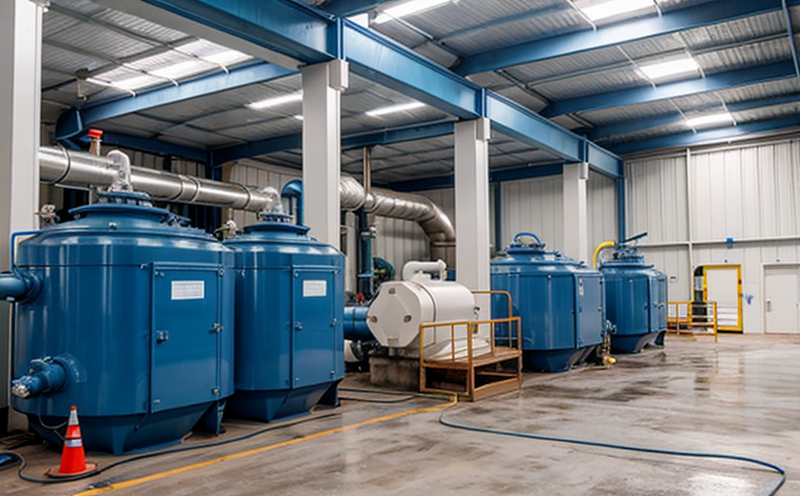EPA Method 200.7 Metals Analysis in Ballast Water
The Environmental Protection Agency's (EPA) Method 200.7 is a standardized procedure for the quantitative determination of metals, particularly copper and zinc, in ballast water samples from vessels. This method is crucial for ensuring compliance with regulations aimed at preventing the introduction of harmful aquatic organisms and pathogens through ship ballast water exchange.
The primary purpose of EPA Method 200.7 is to provide a reliable means of detecting metals that are commonly found in ballast water, which can serve as indicators of potential contamination or treatment effectiveness. The method involves the use of inductively coupled plasma optical emission spectrometry (ICPOES) for metal quantification.
Before conducting the analysis, it is essential to properly collect and prepare the ballast water samples. Samples should be collected from a representative location within the ship's ballast tanks and transferred into clean containers without introducing any contaminants. The preparation process involves filtering the sample through 0.45 μm filters to remove suspended solids.
The analysis itself proceeds as follows: the filtered sample is then diluted if necessary, ensuring that it falls within the linear range of the instrument. Once prepared, the solution is injected into the spectrometer for measurement. The method provides accurate results when operated under strict calibration and quality control protocols. It should be noted that this process requires expertise in both sample handling and instrumental operation to ensure accurate and reproducible results.
The significance of EPA Method 200.7 extends beyond mere compliance; it plays a critical role in the development and validation of ballast water treatment technologies. By providing precise measurements, the method helps researchers and engineers assess the effectiveness of various treatment methods designed to reduce metal concentrations and other contaminants.
Furthermore, this method supports regulatory bodies like the International Maritime Organization (IMO) which mandates that ships comply with specific limits on metal content in ballast water. Compliance with EPA Method 200.7 ensures that vessels meet these international standards, thereby protecting marine ecosystems from invasive species and pollutants.
Understanding the nuances of this method is vital for those involved in maritime operations, particularly quality managers, compliance officers, R&D engineers, and procurement staff. The accuracy of EPA Method 200.7 contributes significantly to maintaining environmental integrity while facilitating smoother regulatory processes.
To sum up, EPA Method 200.7 is an indispensable tool for the accurate quantification of metals in ballast water. Its application not only ensures compliance with stringent regulations but also supports advancements in ballast water treatment technology, ultimately fostering a healthier and more sustainable marine environment.
Benefits
- Comprehensive Compliance: Ensures that all samples adhere to EPA standards for metal content in ballast water.
- Precision and Reliability: Provides accurate quantitative data on metals, enhancing trustworthiness of results.
- Supports Innovation: Facilitates the development and validation of new treatment technologies for ballast water.
- Environmental Protection: Helps prevent the introduction of harmful aquatic organisms and pathogens.
- Regulatory Compliance: Assures that vessels meet international standards set by bodies like the IMO.
- Data Integrity: Ensures reliable data for environmental impact assessments and compliance audits.
Quality and Reliability Assurance
The quality and reliability of EPA Method 200.7 are paramount in ensuring accurate metal content measurements in ballast water samples. To achieve this, several key steps must be followed:
- Sophisticated Instrumentation: Utilize state-of-the-art inductively coupled plasma optical emission spectrometers (ICPOES) to ensure precise readings.
- Calibration Protocols: Regular calibration of the instrument against known standards is essential for maintaining accuracy and precision.
- Quality Control Procedures: Implement rigorous quality control measures, including internal audits and external validations, to identify and rectify any discrepancies in results.
These stringent protocols not only enhance the reliability of the test but also contribute significantly to the overall integrity of the environmental data collected. By adhering to these standards, laboratories can provide clients with confidence that they are meeting regulatory requirements and contributing positively to global environmental conservation efforts.
International Acceptance and Recognition
EPA Method 200.7 is widely recognized and accepted by numerous international bodies, including the International Maritime Organization (IMO), which has established stringent regulations for ballast water management. The method's acceptance is rooted in its rigorous scientific foundation and consistent application across various testing facilities.
One of the key reasons for this widespread recognition lies in the method's ability to provide consistent and reliable results, which are essential for enforcing global standards on metal content in ballast water. This consistency ensures that all stakeholders, whether they be regulatory bodies or vessel operators, can rely on these measurements.
The IMO has incorporated EPA Method 200.7 into its Ballast Water Management Convention (BWM), which sets limits for the concentration of various substances, including metals, in ballast water. By aligning with this convention, laboratories using EPA Method 200.7 contribute to a global effort aimed at reducing environmental impacts and promoting sustainable maritime practices.
In addition to its acceptance by international bodies, EPA Method 200.7 is also widely used in national regulatory frameworks. This broad recognition underscores the importance of this method in maintaining a harmonized approach to ballast water management across different jurisdictions.
The global adoption of EPA Method 200.7 not only facilitates uniform compliance with international standards but also enhances collaboration among various stakeholders, including governments, industry associations, and environmental organizations. This collaborative effort is crucial for addressing the complex challenges associated with maritime environmental protection effectively.





